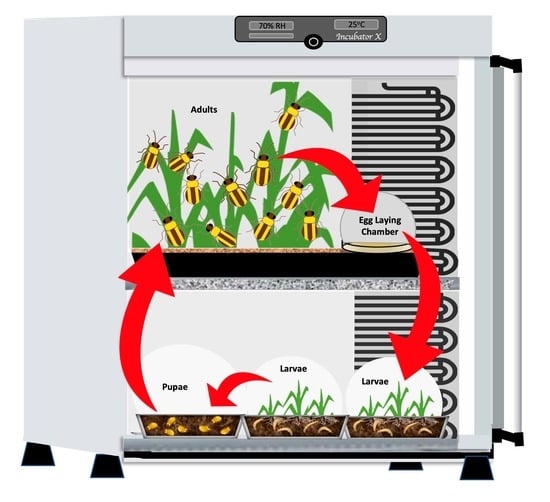An Optimized Small-Scale Rearing System to Support Embryonic Microinjection Protocols for Western Corn Rootworm, Diabrotica virgifera virgifera
Abstract
Simple Summary
Abstract
1. Introduction
2. Materials and Methods
2.1. Source of Insect Strains
2.2. Details of the Rearing Protocol
2.2.1. Rearing Conditions
2.2.2. Preparation of Sprouted Corn
2.2.3. Single-Pair and Colony-Level Egg Laying
2.2.4. Egg Collection and Incubation
2.2.5. Preparing Primary Rearing Containers
2.2.6. Preparing Secondary and Tertiary Rearing Containers
2.2.7. Preparing Pupal Rearing Containers
2.2.8. Adult Collection for Colony- or Single-Pair Mating
2.3. Development Time, Eclosion Efficiency after Handling, and Quality Control
2.4. Fluorescent Light Screening
2.5. Single Pupae Handling and Survival Rate
2.6. Testing Single-Pair Mating Scheme
3. Results
3.1. Developmental Rate
3.2. Survival Rate
3.3. Quality Control System
3.4. Impact of Fluorescent Light Screening
3.5. Handling and Sexing Pupae
3.6. Single-Pair Crosses
4. Discussion
5. Conclusions
Supplementary Materials
Author Contributions
Funding
Data Availability Statement
Acknowledgments
Conflicts of Interest
References
- Gray, M.E.; Sappington, T.W.; Miller, N.J.; Moeser, J.; Bohn, M.O. Adaptation and invasiveness of western corn rootworm: Intensifying research on a worsening pest. Annu. Rev. Entomol. 2009, 54, 303–321. [Google Scholar] [PubMed]
- Georce, B.W.; Ortman, E.E. Rearing the western corn rootworm in the laboratory. J. Econ. Entomol. 1965, 58, 375–377. [Google Scholar] [CrossRef]
- Bigger, J.; March, R. Rearing southern corn rootworms on seedling corn plants. J. Econ. Entomol. 1943, 36, 349–350. [Google Scholar] [CrossRef]
- Branson, T.F.; Guss, P.; Krysan, J.; Sutter, G. Corn Rootworms: Laboratory Rearing and Manipulation; US Department of Agriculture, National Agricultural Library: Washington DC, USA, 1975.
- Branson, T.F.; Jackson, J.J.; Sutter, G.R. Improved method for rearing Diabrotica virgifera virgifera (Coleoptera, Chrysomelidae). J. Econ. Entomol. 1988, 81, 410–414. [Google Scholar] [CrossRef]
- Dominique, C.R.; Yule, W.N. Laboratory rearing technique for the northern corn rootworm, Diabrotica longicornis (Coleoptera, Chrysomelidae). Can. Entomol. 1983, 115, 569–571. [Google Scholar] [CrossRef]
- Jackson, J.; Davis, D. Rearing western corn rootworm larvae on seedling corn (Coleoptera: Chrysomelidae). J. Kans. Entomol. Soc. 1978, 353–355. [Google Scholar]
- Branson, T. The selection of a non-diapause strain of Diabrotica virgifera (Coleoptera: Chrysomelidae). Entomol. Exp. Appl. 1976, 19, 148–154. [Google Scholar] [CrossRef]
- Cohen, C.C. Insect Diets: Science and Technology, 2nd ed.; CRC Press: Boca Raton, FL, USA, 2015. [Google Scholar]
- Huynh, M.P.; Nielson, C.; Wade French, B.; Ludwick, D.C.; Geisert, R.W.; Pereira, A.E.; Barry, J.; Meihls, L.N.; Schneider, S.K.; Hibbard, B.E. Development of a nondiapausing strain of northern corn rootworm with rearing techniques for both diapausing and nondiapausing strains. Sci. Rep. 2021, 11, 17944. [Google Scholar] [CrossRef]
- Meinke, L.J.; Siegfried, B.D.; Wright, R.J.; Chandler, L.D. Adult susceptibility of Nebraska western corn rootworm (Coleoptera: Chrysomelidae) populations to selected insecticides. J. Econ. Entomol. 1998, 91, 594–600. [Google Scholar] [CrossRef]
- Miota, F.; Scharf, M.E.; Ono, M.; Marcon, P.; Meinke, L.J.; Wright, R.J.; Chandler, L.D.; Siegfried, B.D. Mechanisms of methyl and ethyl parathion resistance in the western corn rootworm (Coleoptera: Chrysomelidae). Pestic. Biochem. Physiol. 1998, 61, 39–52. [Google Scholar]
- Wright, R.J.; Scharf, M.E.; Meinke, L.J.; Zhou, X.G.; Siegfried, B.D.; Chandler, L.D. Larval susceptibility of an insecticide-resistant western corn rootworm (Coleoptera: Chrysomelidae) population to soil insecticides: Laboratory bioassays, assays of detoxification enzymes, and field performance. J. Econ. Entomol. 2000, 93, 7–13. [Google Scholar] [CrossRef] [PubMed][Green Version]
- Gassmann, A.J.; Petzold-Maxwell, J.L.; Clifton, E.H.; Dunbar, M.W.; Hoffmann, A.M.; Ingber, D.A.; Keweshan, R.S. Field-evolved resistance by western corn rootworm to multiple Bacillus thuringiensis toxins in transgenic maize. Proc. Natl. Acad. Sci. USA 2014, 111, 5141–5146. [Google Scholar] [CrossRef] [PubMed]
- Meihls, L.N.; Higdon, M.L.; Siegfried, B.D.; Miller, N.J.; Sappington, T.W.; Ellersieck, M.R.; Spencer, T.A.; Hibbard, B.E. Increased survival of western corn rootworm on transgenic corn within three generations of on-plant greenhouse selection. Proc. Natl. Acad. Sci. USA 2008, 105, 19177–19182. [Google Scholar] [CrossRef]
- Branson, T.F.; Johnson, R.D. Adult western corn rootworms: Oviposition, fecundity, and longevity in the laboratory. J. Econ. Entomol. 1973, 66, 417–418. [Google Scholar] [CrossRef]
- Hill, R.E. Mating, oviposition patterns, fecundity and longevity of the western corn rootworm. J. Econ. Entomol. 1975, 68, 311–315. [Google Scholar] [CrossRef]
- Jackson, J.J. Rearing and handling of Diabrotica virgifera and Diabrotica undecimpunctata howardi. In Methods for the Study of Pest Diabrotica; Krysan, J.L., Miller, T.A., Eds.; Springer: New York, NY, USA, 1986; pp. 25–47. [Google Scholar]
- Lefko, S.A.; Nowatzki, T.M.; Thompson, S.D.; Binning, R.R.; Pascual, M.A.; Peters, M.L.; Simbro, E.J.; Stanley, B.H. Characterizing laboratory colonies of western corn rootworm (Coleoptera: Chrysomelidae) selected for survival on maize containing event DAS-59122-7. J. Appl. Entomol. 2008, 132, 189–204. [Google Scholar] [CrossRef]
- Krysan, J.L. Introduction: Biology, distribution, and identification of pest Diabrotica. In Methods for the Study of Pest Diabrotica; Krysan, J.L., Miller, T.A., Eds.; Springer: New York, NY, USA, 1986; pp. 1–23. [Google Scholar]
- Chu, F.-C.; Klobasa, W.; Wu, P.-S.; Pinzi, S.; Grubbs, N.; Gorski, S.; Cardoza, Y.; Lorenzen, M.D. Germline transformation of the western corn rootworm, Diabrotica virgifera virgifera. Insect Mol. Biol. 2017, 26, 440–452. [Google Scholar] [CrossRef] [PubMed]
- Chu, F.-C.; Wu, P.-S.; Pinzi, S.; Grubbs, N.; Lorenzen, M.D. Microinjection of western corn rootworm, Diabrotica virgifera virgifera, embryos for germline transformation, or CRISPR/Cas9 genome editing. J. Vis. Exp. 2018, 134, 57497. [Google Scholar]
- ODell, T.M. Straggling in gypsy moth production strains: A problem analysis for developing research priorities. In Advances in Insect Rearing for Research and Pest Management; Anderson, T.E., Ed.; CRC Press: Boca Raton, FL, USA, 1993; pp. 325–350. [Google Scholar]
- Odell, T.M.; Keena, M.A.; Willis, R.B. Dietary influence of iron formulation on the development of gypsy moth (Lepidoptera: Lymantriidae) in laboratory colonies. Annu. Rev. Entomol. 1997, 90, 149–154. [Google Scholar]
- Horn, C.; Offen, N.; Nystedt, S.; Häcker, U.; Wimmer, E. piggyBac-Based insertional mutagenesis and enhancer detection as a tool for functional insect genomics. Genetics 2003, 163, 647–661. [Google Scholar] [CrossRef]
- Cohen, C.C. Ecology of Insect Rearing Systems: A Mini-Review of Insect Rearing Papers from 1906–2017. Adv. Entomol. 2018, 6, 86–115. [Google Scholar] [CrossRef]
- Li, H.; Guillemaud, T.; French, B.W.; Kuhlmann, U.; Toepfer, S. Phenotypic trait changes in laboratory—Reared colonies of the maize herbivore, Diabrotica virgifera virgifera. Bull. Entomol. Res. 2014, 104, 97–115. [Google Scholar] [CrossRef] [PubMed]
- Cates, M.D. Behavioral and Physiological Aspects of Mating and Oviposition by the Adult Western Corn Rootworm, Diabrotica virgifera LeConte. Ph.D. Dissertation, The University of Nebraska-Lincoln, Lincoln, NE, USA, 1968. [Google Scholar]
- Branson, T.; Guss, P.; Jackson, J. Mating frequency of the western corn rootworm. Ann. Entomol. Soc. Am. 1977, 70, 506–508. [Google Scholar] [CrossRef]
- Klobasa, W.; Chu, F.C.; Huot, O.; Grubbs, N.; Rotenberg, D.; Whitfield, A.E.; Lorenzen, M.D. Microinjection of corn planthopper, Peregrinus maidis, embryos for CRISPR/Cas9 genome editing. J. Vis. Exp. 2021, 169, e62417. [Google Scholar]
- Dossey, A.T.; Oppert, B.; Chu, F.C.; Lorenzen, M.D.; Scheffler, B.; Simpson, S.; Koren, S.; Johnston, J.S.; Kataoka, K.; Ide, K. Genome and genetic engineering of the house cricket (Acheta domesticus): A resource for sustainable agriculture. Biomolecules 2023, 13, 589. [Google Scholar] [CrossRef] [PubMed]
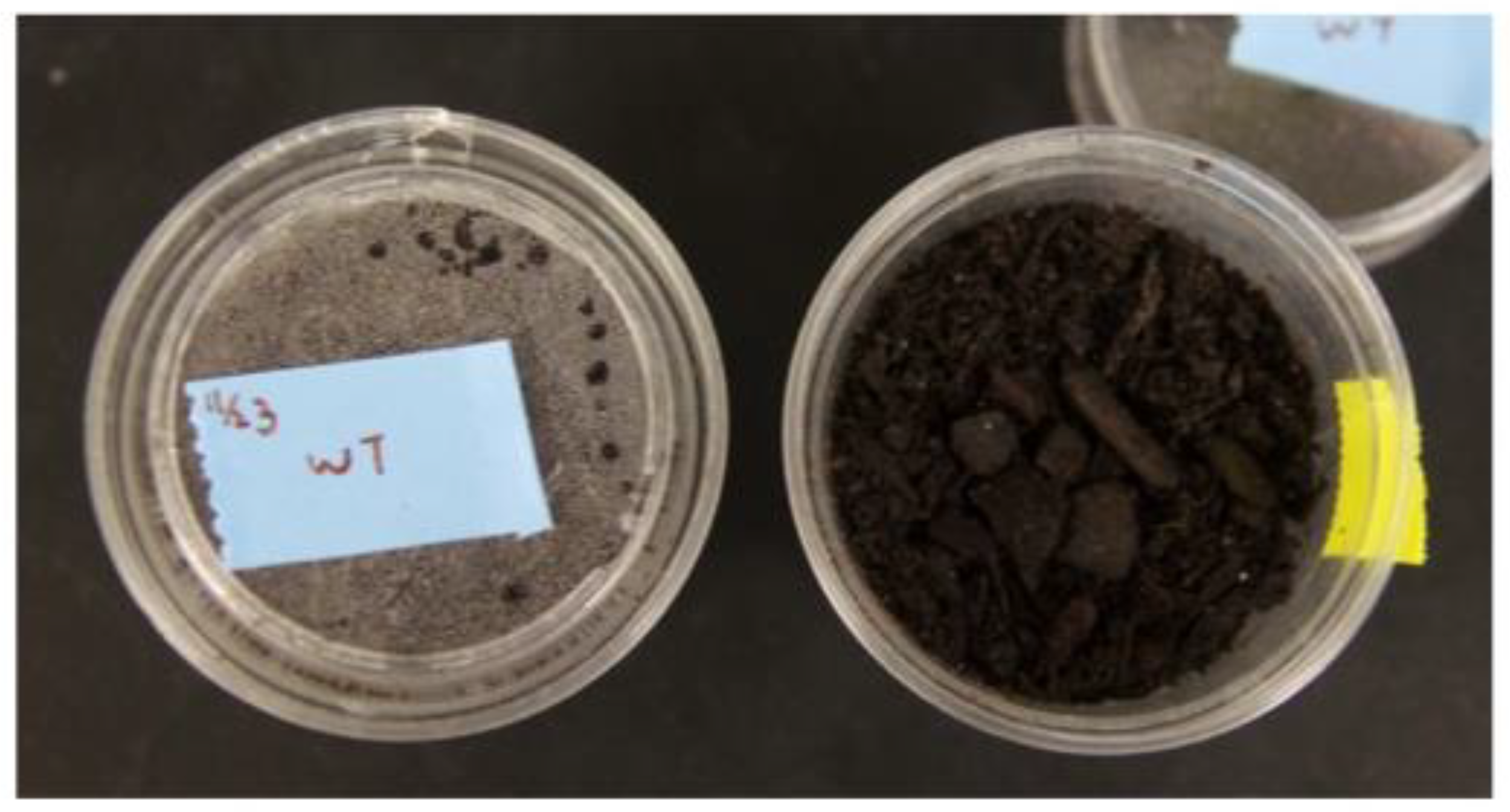

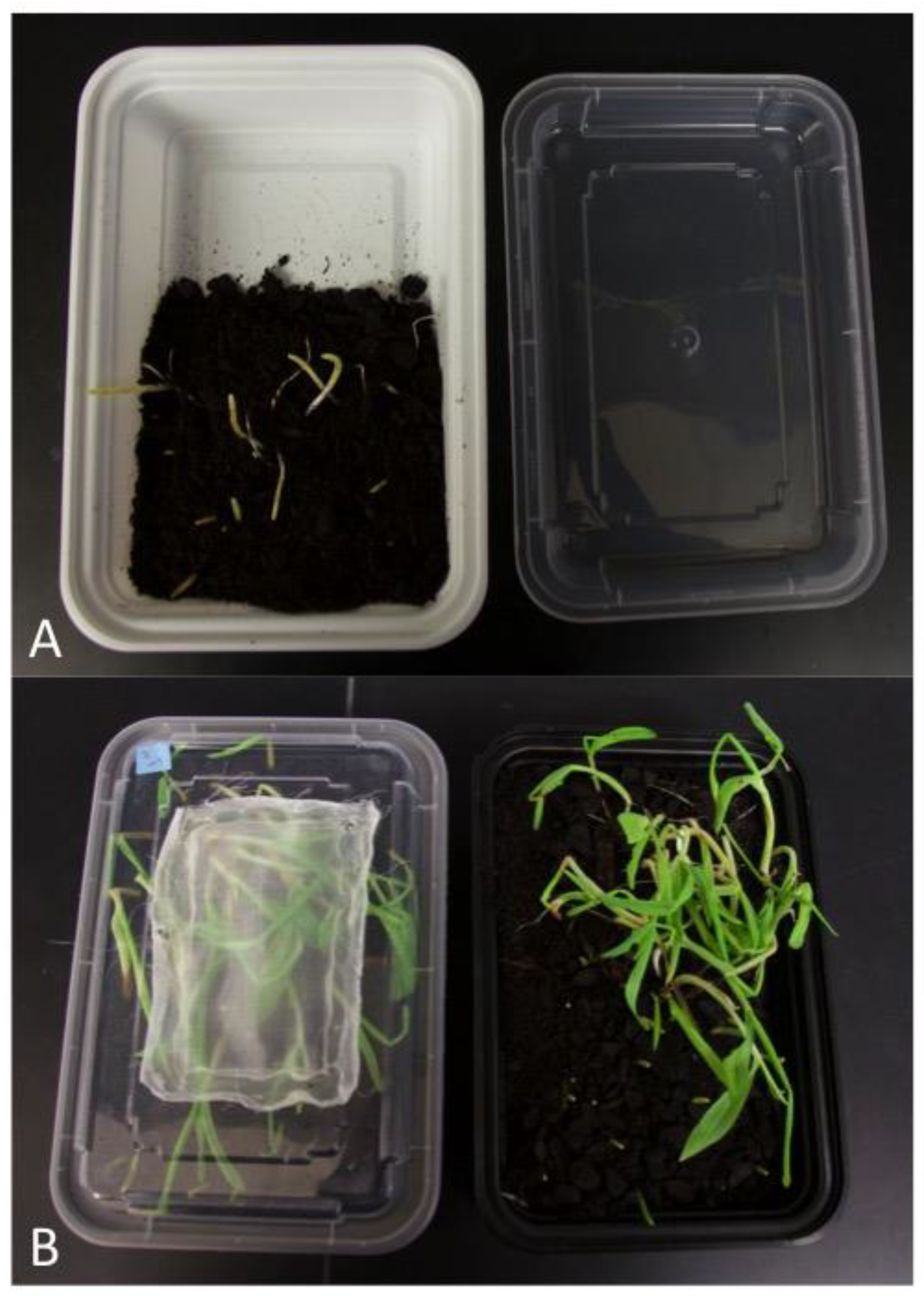

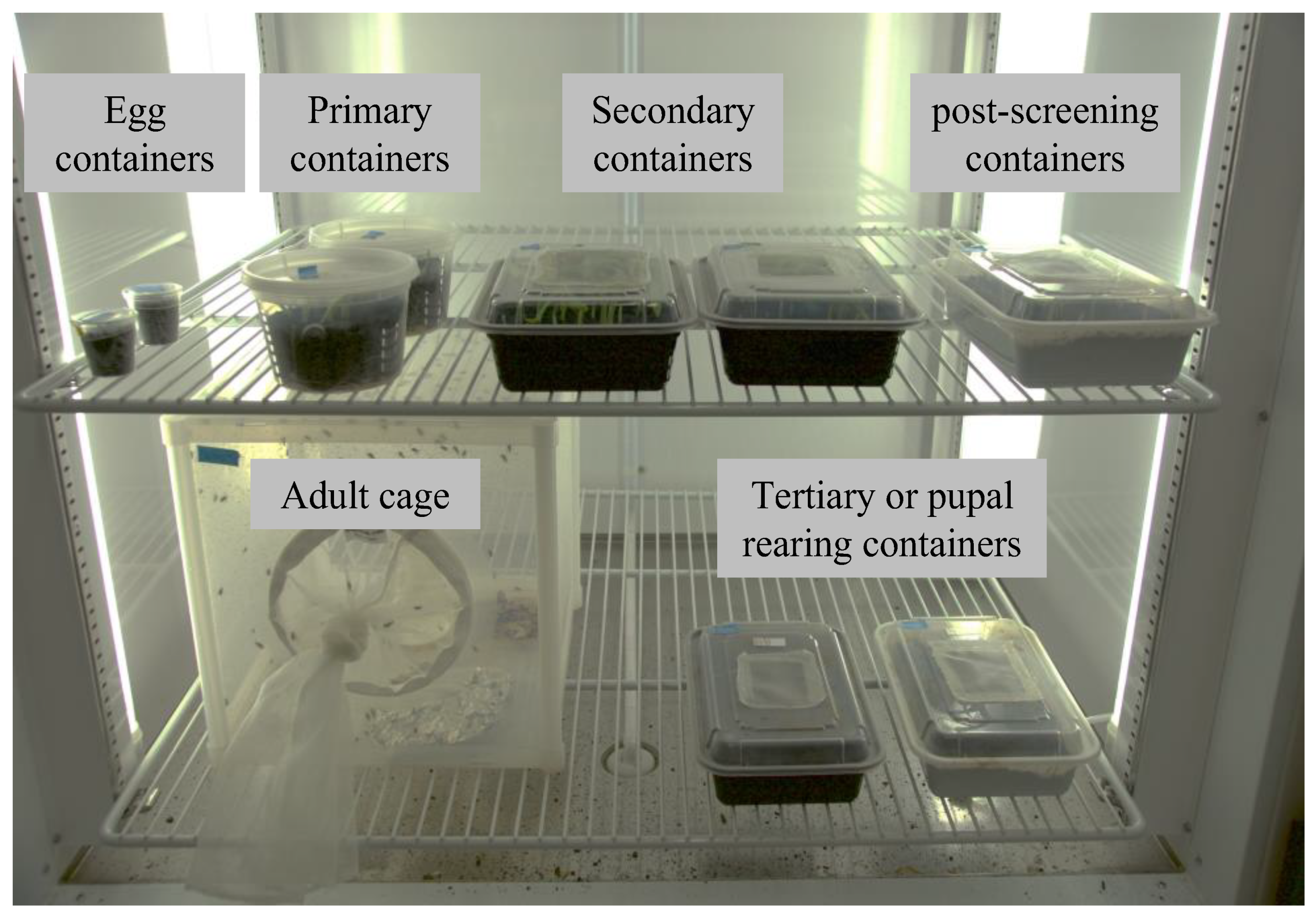
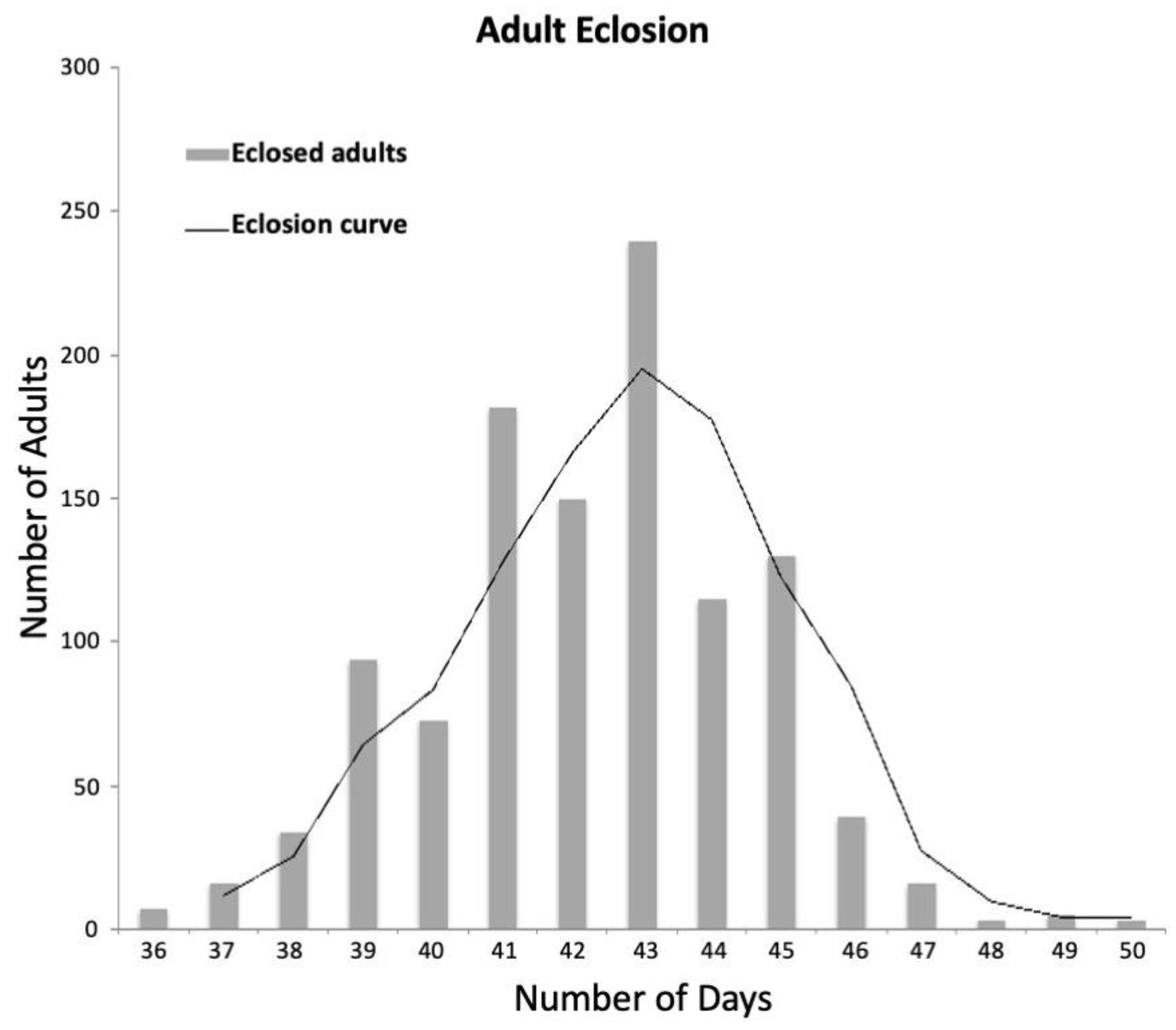
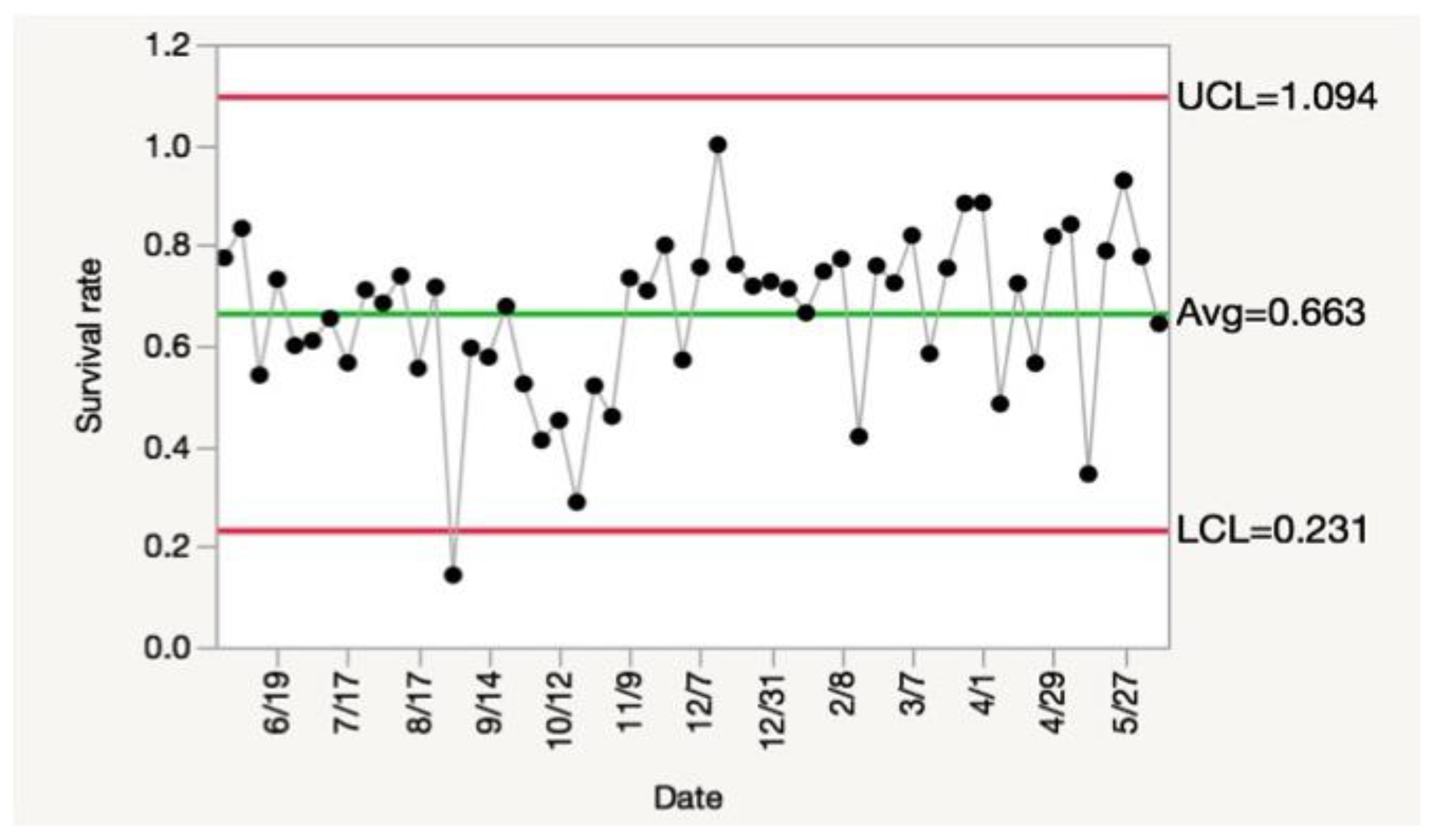
| Stage | # of Insects | # of Adults | Survival Rate |
|---|---|---|---|
| Larvae | 3260 | 2675 | 82.06% |
| Pre/pupae 1 | 2184 | 1223 | 56.00% |
| Mix 2 | 2146 | 1586 | 73.90% |
| Total | 7590 | 5484 | 72.25% |
| Life Stage | # of Insects | # of Adults | Eclosion Rate |
|---|---|---|---|
| Larvae | 480 | 438 | 91.25% |
| Pre-pupae | 2630 | 1798 | 68.37% |
| Pupae | 4766 | 3950 | 82.88% |
| Pre/pupae | 818 | 652 | 79.71% |
| This Work | 1973 * | 1972 + | ||||
|---|---|---|---|---|---|---|
| Range | Mean | Range | Mean | Range | Mean | |
| Female longevity (days) | 31–132 | 78.4 ± 32.6 | 6–163 | 67.7 ± 30.6 | 19–126 | 94.8 ± 12.5 |
| No. eggs oviposited/female | 83–1070 | 414 ± 290.3 | 237–912 | 593.l ± 231.3 | 85–1913 | 1023 ± 240 |
| No. clutches/female | 3–17 | 8.1 ± 5 | 3–20 | 11.3 ± 5.4 | ||
| Avg no. eggs/clutch/female | 1–128 | 54.42 ± 25.7 | 39–79 | 56.9 ± 14.2 | ||
| Avg days between ovarian cycles | 1–11 | 4.63 ± 2.3 | 4.2–6.0 | 4.9 ± 0.4 | ||
| Preoviposition period (days) | 13–40 | 19.3 ± 8 | 11–19 | 15.3 ± 2.0 | ||
Disclaimer/Publisher’s Note: The statements, opinions and data contained in all publications are solely those of the individual author(s) and contributor(s) and not of MDPI and/or the editor(s). MDPI and/or the editor(s) disclaim responsibility for any injury to people or property resulting from any ideas, methods, instructions or products referred to in the content. |
© 2023 by the authors. Licensee MDPI, Basel, Switzerland. This article is an open access article distributed under the terms and conditions of the Creative Commons Attribution (CC BY) license (https://creativecommons.org/licenses/by/4.0/).
Share and Cite
Chu, F.-C.; Wu, P.-S.; Pinzi, S.; Grubbs, N.; Cohen, A.C.; Lorenzen, M.D. An Optimized Small-Scale Rearing System to Support Embryonic Microinjection Protocols for Western Corn Rootworm, Diabrotica virgifera virgifera. Insects 2023, 14, 683. https://doi.org/10.3390/insects14080683
Chu F-C, Wu P-S, Pinzi S, Grubbs N, Cohen AC, Lorenzen MD. An Optimized Small-Scale Rearing System to Support Embryonic Microinjection Protocols for Western Corn Rootworm, Diabrotica virgifera virgifera. Insects. 2023; 14(8):683. https://doi.org/10.3390/insects14080683
Chicago/Turabian StyleChu, Fu-Chyun, Pei-Shan Wu, Sofia Pinzi, Nathaniel Grubbs, Allen Carson Cohen, and Marcé D. Lorenzen. 2023. "An Optimized Small-Scale Rearing System to Support Embryonic Microinjection Protocols for Western Corn Rootworm, Diabrotica virgifera virgifera" Insects 14, no. 8: 683. https://doi.org/10.3390/insects14080683
APA StyleChu, F.-C., Wu, P.-S., Pinzi, S., Grubbs, N., Cohen, A. C., & Lorenzen, M. D. (2023). An Optimized Small-Scale Rearing System to Support Embryonic Microinjection Protocols for Western Corn Rootworm, Diabrotica virgifera virgifera. Insects, 14(8), 683. https://doi.org/10.3390/insects14080683







